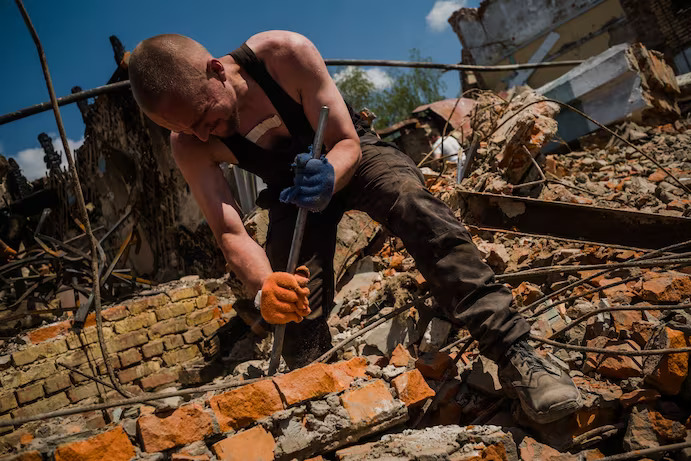Featured Galleries USUBC COLLECTION OF OVER 160 UKRAINE HISTORIC NEWS PHOTOGRAPHS 1918-1997
 Holodomor Posters
Holodomor Posters

IS THERE ENOUGH MONEY TO REBUILD UKRAINE?

Op-Ed by the Editorial Board
The Washington Post
Wash, D.C., Sat, Jun 24, 2023
Planning for Ukraine’s reconstruction needs to start now, even as combat intensifies during Kyiv’s counteroffensive.

Volunteers clean an area destroyed in a strike in Kharkiv, Ukraine, on May 3, 2022.
Photo by Wojciech Grzedzinski for The Washington Post
A big international conference this week on rebuilding Ukraine featured a word salad of code words: building back better; winning the peace; prioritizing people. Each denotes an important means by which the country might rise from the ashes of Russia’s predations — replacing fossilized Soviet facilities with new ones up to European standards; reshaping oligarch-influenced agencies as efficient government institutions; creating housing, schools and jobs to encourage millions of Ukrainian refugees to come home and help rebuild their shattered country.
But those ambitious goals were discussed amid the rumble of a hard reality: the huge obstacles that Ukraine has to overcome to attract the $400 billion to $1 trillion it will need to make itself whole when the guns stop blazing.
Planning for Ukraine’s reconstruction needs to start now, even as combat intensifies during Kyiv’s counteroffensive. But the staggering sums required to do the job are beyond what is financially, logistically and politically feasible for the foreseeable future. The result is that a growing chorus of Ukraine’s allies says the only way to overcome that conundrum is one fraught with legal and financial peril — namely, confiscating some $300 billion in frozen Russian state assets and using them for Ukraine’s reconstruction, a virtually unprecedented act.
That view was an undercurrent to the happy talk in London about Ukraine’s undeniable progress in reforming its government and attacking corruption. Yet the titanic problem of finding the necessary funds was plain.
Ukraine is already struggling to pay its short-term bills. As the conference on Ukraine convened, aid packages to help stabilize Kyiv’s finances — including paying government and military salaries — were announced by the European Union, the United States, Britain and others. Yet the biggest of those, a proposal by the E.U. to provide Kyiv with $55 billion through 2027, featured less than $19 billion in grants.
That would leave Ukraine, whose economy has shrunk by a third since Russia’s invasion, to repay the balance, some $36 billion in loans. What’s more, the E.U.’s overall proposal was at the lower end of a range of up to nearly $80 billion.
The West hopes much of the eventual rebuilding cost will be borne by private companies hoping for profits. Yet there is little chance of that without an international effort to provide insurance against the ongoing risk of future Russian missile strikes that could lay waste to half-finished factories and office buildings — and to hopes for Ukraine’s revival. Despite initiatives announced in London by British Prime Minister Rishi Sunak and other European officials, it remains uncertain how that insurance will be financed in the long term.
Little wonder, then, that calls to use the roughly $300 billion in seized Russian sovereign assets are rising to a crescendo. In Congress, bipartisan legislation has been submitted to allow the president to confiscate Russian state assets held in the United States and earmark them for Ukraine’s reconstruction. In Britain, the government has similarly proposed a measure that would allow the frozen assets to be “donated” to rebuild Ukraine — and meanwhile maintain sanctions against Russia.
Perhaps most significantly, the European Commission is drafting a plan, expected by midsummer, to use investment earnings generated by the frozen Russian assets, some $220 billion of which are held in European banks, for the same purpose.
The moral case is unarguable: Russia, having laid waste to Ukraine, should be forced to pay the lion’s share of reconstruction costs. The political case is also compelling. As the United States and Europe struggle to ward off recession, their appetite for earmarking enormous new sums for Ukraine is likely to be limited. The more they can tap into the Russian assets, the less they will need from their own taxpayers.
What’s more, the most likely means to secure long-term financing for Ukraine from the International Monetary Fund, a key player, will be predicating repayment on Kyiv’s eventual access to the Russian assets. That would be uncharted territory for the IMF and among the riskiest bets it has ever made. Without it, however, Ukraine’s full recovery is unlikely.
Confiscating Russian funds is a dangerous proposition, no matter how strong the moral, political and financial case. The assets themselves are protected under international law, and any legal challenge to seize them would be tied up in courts for years. Even using the predicted earnings generated by those assets is risky, as it could expose the United States and Europe to sizable losses if markets tank.
The broader risk is to the stability and prestige of the dollar and the euro, the two largest international reserve currencies. Countries that park their assets in dollars or euros, including China, might reassess if they see those assets are subject to confiscation. That could shake the foundations of international finance. The European Central Bank and U.S. Treasury Secretary Janet L. Yellen are among those who have warned that seizing Russian assets could have grave consequences.
The sobering conclusion is that even if the war draws to an end soon, which is unlikely, Ukraine’s long path to recovery will pose an ongoing challenge to the West. Yet promoting its success is also the surest way to show that Russia’s neo-imperial land grab has failed.
LINK: https://www.washingtonpost.com/opinions/2023/06/24/ukraine-reconstruction-cost-russian-assets/










